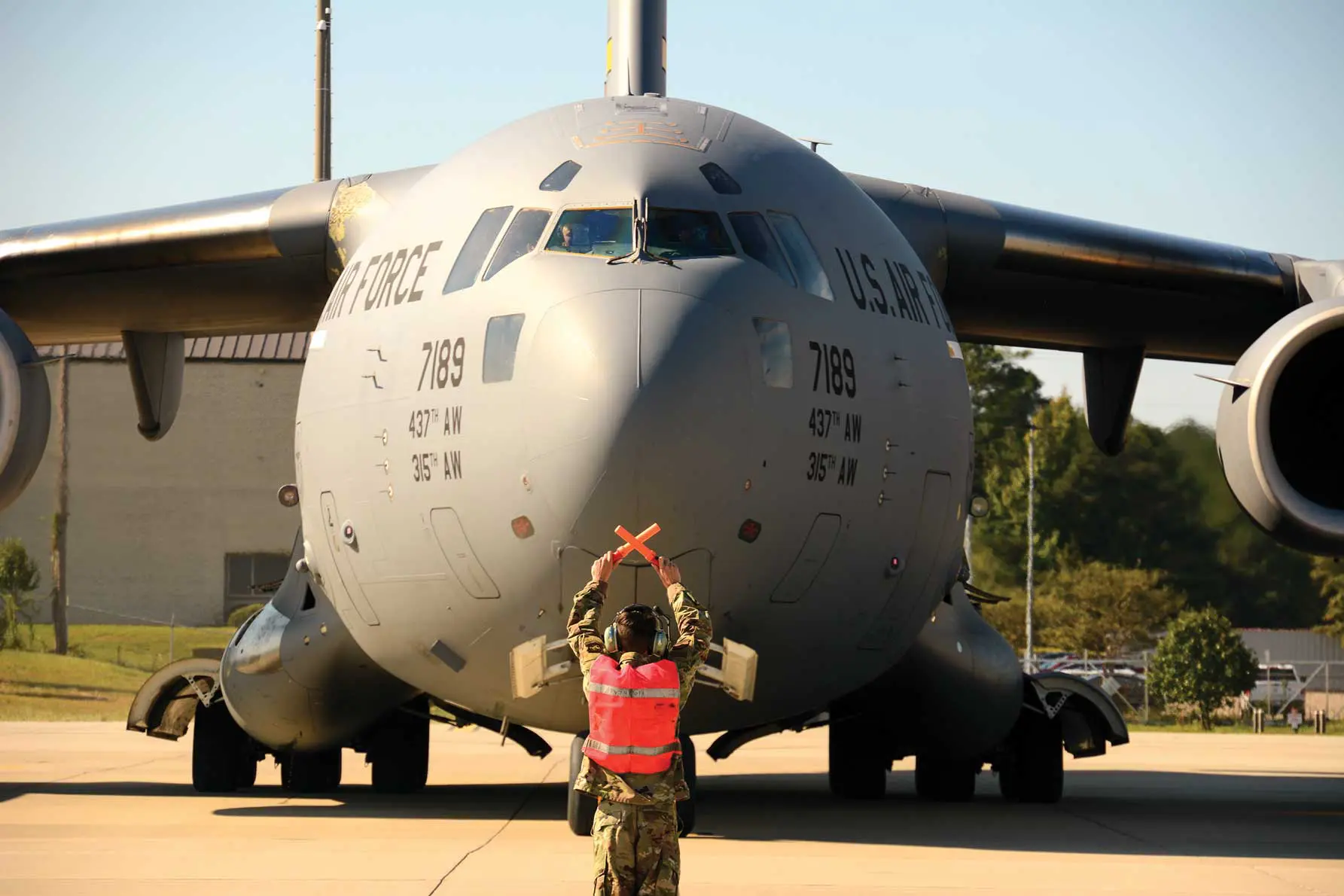The 43d Air Mobility Operations Group: Continuously Aiming High
By MS. LAUREN SCHATZ, STAFF WRITER
The 43d Air Mobility Operations Group (AMOG) is a prime example that indicates you can teach an old dog new tricks. The group has shown historical success but does not allow complacency to stifle its preparation for the future fight.
The 43 AMOG plays a crucial role in rapid strategic deployment when the nation faces a crisis. It is best known for its support of the out-load missions of the Joint Special Operations Command and the U.S. Army’s XVIII Airborne Corps and 82d Airborne Division missions. This Fort Bragg, NC, military installation is informally referred to as the president’s 9-1-1 and is called when a humanitarian or combat situation needs boots on the ground—and fast.
Operating out of Pope Army Airfield in Fort Bragg, the group comprises over 700 Airmen and civilians. It catalyzes swift response through its Airborne Joint Forcible Entry, combat airlift, aeromedical evacuation, aerial port, command and control, and other enabling capabilities.
Its service began as the 43d Bombardment Group flying B-17s during World War II (WWII) and quickly became known as one of the most innovative, aggressive, and effective flying units. It has maintained an enterprising spirit throughout its history, with each generation of Airmen carrying the torch throughout several transitions following WWII, personifying the motto of Willing, Able, Ready. The unit was designated as 43 AMOG on June 14, 2016, and has continued to exemplify a steadfast commitment to achievement and improvement.
Mr. Frank Laras, a former 43d Airlift Wing Vice Commander and now Chief of the 43 AMOG Business Office, has a strong grip on the 43d’s operational capabilities. With over 20 years of experience at Pope, he has overseen three organizational transitions. Laras gave insight into the current training efforts and plans.
When not in combat scenarios, the Airmen, including those in personnel, medical, logistics, supply, and mainÂtenance, are in constant preparation for joint contingency deployments. The group conducts frequent exercises varying in magnitude. “We will use two all the way up to 12 aircraft in a variety of contingency scenarios,†Laras explained.
Exercises are executed year-round, and the mock environments of the exercises are crafted to be as realistic as possible. “They will fly over simulated hostile zones, airdrop, and continue to play out the simulated combat scenario on the ground,†Laras said.
Training is under continual evaluation, and assessments are scheduled to ensure frequency. For example, after-action reports are generated after each exercise, and the lessons contained in these reports are applied in the subsequent exercises. Additionally, leadership meets on a set basis to brainstorm on how to improve. In these meetings, input from Airmen on every level is taken into consideration, and ideas are tested and evaluated.
Laras shared a unique idea that was implemented. He explained there was a time when drop zones would be heavily lit up so the aircrews could identify them. However, it was brought up that this method did not reflect a realistic combat scenario, in which there would not be time to place lights to illuminate the dark drop zones. Therefore, a new method, which involves sight-angle dropping and a laser-pointer-like device that fighter escort pilots can wear on their fingers and use to “mark†the point of impact on the ground, was born. This idea is just one of the many examples of the Air Force’s innovative nature.
The 43 AMOG is currently undergoing a reorganization, or “reorg,†to optimize its support of the national defense strategy. Laras discussed the logistics and implications of the reorg, which he believes will be a positive change because it will further the group’s goal to “do it safely and do it right the first time.â€
The most notable change is the transitioning from a group to a wing. This will entail the addition of two colonel leadership positions as well as an additional group and two squadrons.
Currently, only two colonels are each performing the functions of approxiÂmately six. Laras explains that for effective training, additional coverage is needed. “In a contingency scenario, many of those colonel functions hapÂpen simultaneously,†Laras said.
Laras remarked that the additional leadership will also add more oversight to training, which will be critical to the success of the combat training squadron and optimize current efforts.
“We will utilize the same exercises that the Army uses when they simulate their ground war,†Laras said. “Airmen will have to be watching out for possible simulated threats, such as sniper fire or chemical attacks. Crews will take off just like they would in a combat scenario, which means making the proper calls maneuvers to avoid enroute air and ground threats. This will ensure that everything will not feel new the first time they deploy.â€
Although there will be a heightened focus on expertise, leadership will also ensure Airmen adhere to concepts such as the “multi-capable airmen†which increases proficiency in many of the skills necessary to support air operations in addition to an Airman’s assigned duties.
The 43 AMOG, throughout its history, has served as a prime example of the importance of pushing forward and aiming high. The group’s structured approach to innovation and plans for its reorg allow it to effectively prepare for the future fight. Should the president ring Fort Bragg, Air Force and Army readiness will certainly answer.


